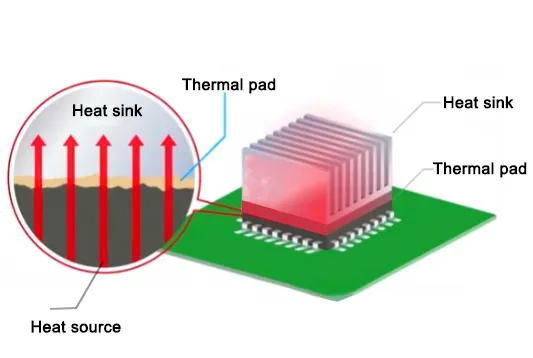Choose the Right Thermal Pads for Thermal Management in Electronics
- Posted on:2023-02-15 09:24:00
- Source:AOK Thermal Pad Manufacturer Industry News
The capacity of an electrical component to dissipate the heat directly impact its performance level and its lifetime. With the miniaturization of the component, dissipate the heat become a critical point in electronics. The right gap filler or thermal pads is more than ever essential.
1. What is the gap to fill with the thermal pads?
The more the gap to be filled is important (especially on boards with high gaps between the higher component and the lower component), the more the thermal pads will need to be thick and flexible.
Large gaps between the closest component to the board and the higher one. In that case, it is better to choose very flexible thermal pads. Like ultra soft thermal pads (in the form of thermal pads with a very soft texture). These thermal pads can reach thicknesses of several mm while maintaining a very high flexibility.
2. What is the thermal power to be dissipated by the thermal pads?
The most efficient thermal pads are graphite-made or metal-filled thermal pads. The thermal conductivity of these thermal pads reaches several thousand W/m.K. These thermal pads however have the drawback of being electrically conductive and are very hard (they compensate less efficiently the backlash and vibrations). The least efficient thermal pads are the ultra soft thermal pads. They are very flexible, but their thermal conductivity is lower. This can be explained by the fact that thermal conductivity is very often linked to the quantity of conductive particles added in the thermal pads. However, a higher charge also directly means a higher hardness.
3. Is there a regular maintenance to plan for the thermal pads?
Maintenance must be considered at the design stage. People that have experienced scrapping thermal paste or cleaning thermal grease creeps from the PCB will understand. “Cleaner” to manipulate alternatives exist, such as thermal interface materials in the form of thermal pads (or thermal blankets). These are thermal interface materials in the form of polymer sheets that can be cut. These thermal pads can reach the same performance levels as the thermal pastes (up to 11W/m.K for the most common). “Putty” thermal pads hardnesses are also very interesting (very smooth/soft).
4. Is there an electrical insulation to ensure by the thermal pads?
In the majority of cases, the answer is yes. Thermal pads by creeping may cover the components legs (for instance a PCBA) on the PCB. In that case, the thermal pads must be a fully electrically insulating.
5. Is the thermal pads in a strict environment (special, medical or military type)?
Silicone thermal pads imply risks of degassing silicone particles over time. This phenomenon is to take into consideration mostly on projects where thermal interface materials are exposed to highly constrained environments. For example, thermal pads that are mounted on space equipment are subjected to vacuum. Silicone particles, which are volatile, may then escape from the thermal pads. This would not only impact its behavior and properties, but also pollute its environment.
If you would like to learn more about AOK performance thermal materials, please visit our website at www.aok-technologies.com.


